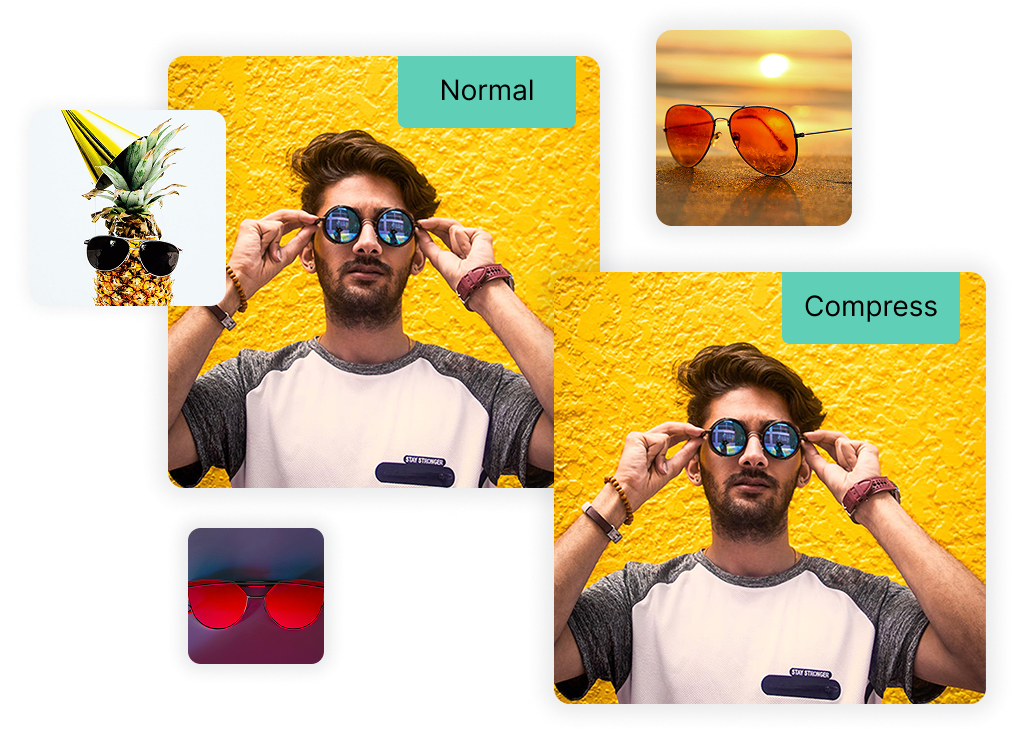Compress JPG
Compress JPG images online with a free JPG optimizer. Drop JPG images below to compress and optimize them in seconds
Compress JPG images online with a free JPG optimizer. Drop JPG images below to compress and optimize them in seconds
Or drag your images here
Sign up to use our free API in your next project and automatically compress images at scale
Easily compress JPG images online instantly and effortlessly. No installation or plugins required. Simply drop your JPG images into our converter, and receive your JPG file in seconds fully optimized with no loss in quality.

You can optimize JPG images on the fly, securely, ad-free and inside your browser.
Developers can get an API to automatically compress their JPG images!

More than compressing your JPGs. Generative Fill, Generative Object Removal and Generative Replace are just a few examples of how AI can enhance and customize images, providing flexibility in content creation.

Whether it’s 3D animations, interactive product displays or real time filtering, Cloudinary’s API gives you a lot of image enhancement features. Developers can easily make older images look great again!

Automatic optimization guarantees that images are delivered in the highest quality and most suitable format for the user’s device, browser, or connection. Whether it’s JPG, PNG, HEIC or any other image format the most efficient format is automatically selected for optimal performance.

Use our compressor to batch compress JPG images, or sign up for our free API to automatically optimize all your JPG images!

Create automated workflows with preset configurations to save time and ensure that files are automatically transformed and ready for delivery right after upload.

Go beyond JPG with support for cutting-edge formats like WEBP, JXL and AVIF. These advanced formats ensure that your visual assets are delivered with the best combination of quality and efficiency.
Use JPG compressor in 3 simple steps, or sign up for Cloudinary to programmatically optimize thousands of your web images!
Upload or drag and drop your images into the browser
Start optimizing your JPG images by compressing them to smaller sizes.
Once the compression is complete, download your optimized JPG images
We’re showing a resized version of the original asset to avoid slow loading speeds. View the original.
Get Answers to Your Questions About Our Chat Software and Features
JPG, or JPEG, stands for Joint Photographic Experts Group, the organization that created this widely-used image format. JPG is known for its efficient lossy compression, which significantly reduces file sizes by selectively discarding some image data. This makes JPG an ideal format for digital photography and web use, where a balance between image quality and file size is essential. Despite the compression, JPG images typically maintain high visual fidelity, making them suitable for detailed and colorful photographs. The format is universally compatible with almost all devices and operating systems, ensuring broad utility across different platforms.
No, it is not possible to compress a JPG without losing some quality because JPG uses lossy compression by design. When a JPG file is compressed, some of the image data is permanently discarded to reduce the file size. This process inevitably results in a loss of image quality, though the degree of loss can be controlled by adjusting the compression level. Higher compression leads to smaller file sizes but more noticeable quality degradation, while lower compression preserves more quality but results in larger file sizes. For truly lossless compression, other formats such as PNG or TIFF would be required, but they do not typically offer the same level of file size reduction as JPG.
The best way to optimize JPG images for web use involves balancing file size with image quality to ensure fast loading times without sacrificing visual appeal. You could by resizing the image to the exact dimensions needed for the website, as larger images require more bandwidth. Next, adjust the compression level to reduce the file size while keeping an eye on the image quality to avoid noticeable degradation. With Cloudinary, you can automatically compress the files as well as get them into the best format.
Yes, converting a JPG to another format like PNG or WEBP can sometimes help reduce file size without losing quality, depending on the image’s content and the target format’s capabilities. PNG is a lossless format, which means it preserves the original image quality, but it may result in larger file sizes than JPG, especially for photos. On the other hand, WEBP, developed by Google, offers both lossy and lossless compression and can achieve smaller file sizes with comparable or better quality than JPG. Converting to WEBP might be a good option for web use, as it can significantly reduce file sizes while maintaining high visual fidelity. However, converting from JPG to a lossless format won’t recover the quality lost during the original JPG compression. Remember that with Cloudinary you can convert to all these formats, as well as automatically convert to the best format via an API.